The writing process is the foundation of every clear, persuasive, and polished piece of text. Understanding how ideas move from first thought to final draft transforms writing from a stressful task into a structured act of reasoning. This article explains each stage in depth, supported by research and real examples, so that anyone—student, researcher, or professional—can learn to write with purpose, focus, and confidence.
What is the Writing Process
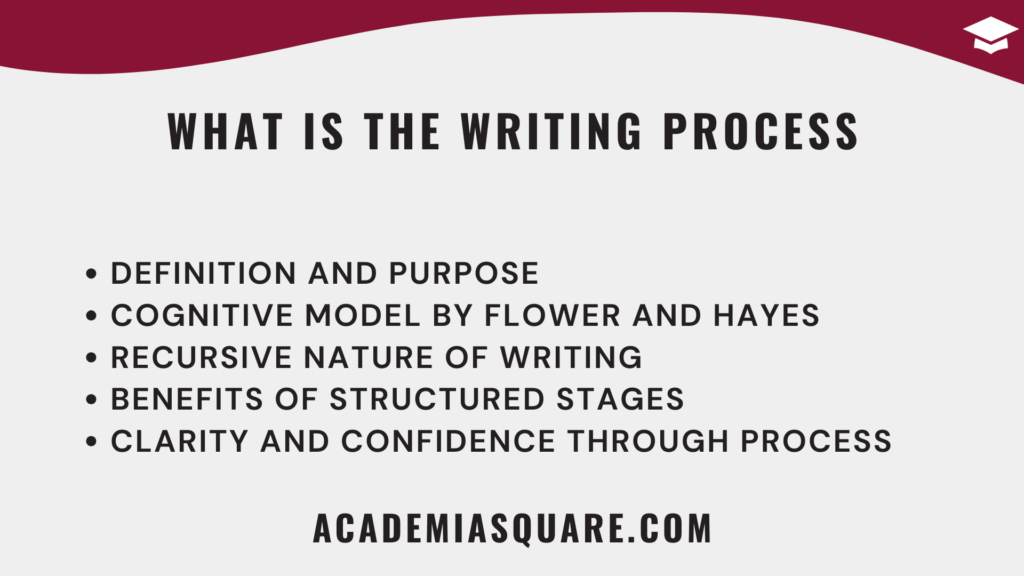
The writing process is the structured series of stages that writers use to transform an initial idea into a finished and polished piece of text. It begins with discovery and planning, moves through drafting and revising, and ends with editing and presentation. Rather than being a single act, writing is a disciplined process of thinking, organizing, and refining. Understanding this process is what separates deliberate, confident writers from those who struggle with disorganized or unclear drafts.
Researchers have long emphasized that writing is not a mechanical skill but a cognitive one. The classic model by Flower and Hayes (1981) described writing as a problem-solving activity involving planning, translating, and reviewing. In other words, writing evolves through a constant dialogue between your thoughts, your structure, and your reader’s expectations. Recognizing that evolution allows you to become intentional about every stage of your work.
- 🧠 Recursive Thinking: The Flower and Hayes Cognitive Process Theory demonstrated that writers loop repeatedly through planning, drafting, and revising rather than moving in a straight line.
- 📚 Improved Quality Through Structure: The Purdue OWL Writing Lab notes that following identifiable stages—prewriting, drafting, revising, editing—leads to more coherent and persuasive outcomes.
- 🎓 Impact on Student Achievement: A 2023 review in the Written Communication journal confirmed that explicit instruction in the writing process significantly improves both student performance and writing confidence.
Why the Writing Process Matters
Writing without a process is like building without a blueprint. You might create something interesting, but it will lack structure, flow, and focus. A defined process gives writers a framework to manage complexity and to stay anchored in purpose. It reduces anxiety by breaking writing into manageable phases rather than facing the intimidating task of producing a finished work all at once.
For academic and professional writers, the writing process provides three key advantages:
- Clarity: Planning and revising help you express complex ideas in logical order.
- Efficiency: Drafting and editing in distinct phases prevent overcorrection or confusion during composition.
- Depth: Revisiting earlier stages allows critical reflection, which enhances quality and insight.
The Main Stages of the Writing Process
Although approaches vary, most educators and researchers agree on five main stages that structure successful writing:
- Prewriting: Generating ideas, setting goals, and understanding your audience.
- Planning: Organizing ideas into a logical outline or structure.
- Drafting: Writing freely without worrying about perfection.
- Revising: Improving content, coherence, and argument flow.
- Editing: Polishing grammar, punctuation, and formatting before submission.
These stages are flexible. Writers often move back and forth between them, which is why the process is called recursive. Each stage builds upon the last and refines what came before, allowing your text to grow in precision and impact.
Applying the Writing Process to Academic and Professional Work
In academic settings, understanding the writing process improves critical thinking and coherence. Studies have shown that structured planning before drafting produces essays with stronger arguments and better organization. In professional writing, whether you are creating a report, proposal, or article, the same process applies—it ensures that every piece is well-reasoned, reader-centered, and polished.
Writers who actively engage in all stages of the writing process gain not only better outcomes but also confidence. They know what to do when they get stuck and how to move forward methodically. Mastery of this process turns writing from an uncertain act into a repeatable skill that supports learning, creativity, and professional success.
By now, you can see that the writing process is the invisible structure behind every strong piece of text. In the next chapter, we will begin the journey at the very start of that structure—the prewriting stage—where ideas take shape and purpose begins to form.
Step 1: Prewriting and Idea Generation
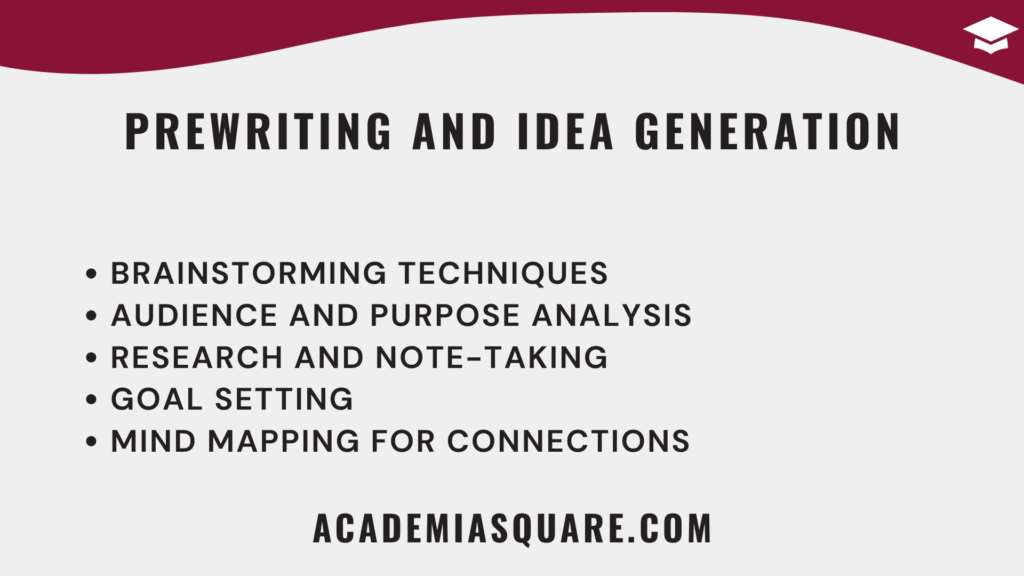
The prewriting stage is where every strong piece of writing begins. It is the moment when ideas start to take shape before a single full sentence appears on the page. In the writing process, prewriting functions as the foundation—it clarifies purpose, audience, and message. Without it, writers often face blocks, incoherence, or endless revision cycles later on.
Prewriting involves discovery and reflection. It is a mix of research, brainstorming, questioning, and mapping out connections. According to Graham and Perin (2012, Educational Researcher), students who spend time planning and organizing before drafting produce writing that is more structured, cohesive, and reader-focused. This phase builds confidence because it gives direction before drafting begins.
- 🧠 Planning Improves Quality: Research by Kellogg (1994, Psychological Science) found that writers who planned before composing generated text with higher conceptual coherence and fewer revisions later.
- 📚 Idea Mapping Supports Creativity: A study in the Written Communication journal (2023) showed that prewriting techniques like clustering and mind-mapping enhance divergent thinking and originality in academic writing.
- 🎯 Audience Awareness Matters: According to the UNC Writing Center, writers who identify their audience early achieve stronger engagement and more persuasive tone throughout the draft.
Prewriting as Intellectual Preparation
Prewriting is both analytical and creative. It asks you to clarify what you want to say and why it matters. Writers use various methods for this purpose, and no single technique fits all. What matters is finding the approach that stimulates genuine discovery.
- Brainstorming: Write down every idea, question, or association without judgment. Quantity leads to quality when you later sort ideas logically.
- Freewriting: Spend 5 to 10 minutes writing continuously about your topic. Do not edit—let your subconscious guide the flow of ideas.
- Clustering or Mind Mapping: Start with a central concept and connect subtopics or supporting ideas visually to see relationships.
- Questioning: Use prompts such as “What am I trying to prove?” or “Why does this matter to my reader?”
Each technique expands thinking in different ways. Mind mapping, for instance, reveals connections between concepts, while freewriting generates raw material that can later evolve into structured arguments.
Research and Information Gathering
Prewriting also includes targeted research. This may involve reading academic papers, reports, or credible online sources. The goal is to understand the conversation around your topic and identify the gap your writing will fill. Taking organized notes or summarizing sources in your own words prevents plagiarism and improves synthesis later.
Effective writers treat research as exploration rather than a checklist. By investigating multiple perspectives, they generate richer insights and avoid bias. A 2020 study in the Journal of Writing Research confirmed that exploratory research before drafting correlates with higher overall argument depth and quality in final essays.
Shaping Direction and Purpose
Once ideas have been generated, writers must define direction. Ask yourself:
- What central question or problem does my writing address?
- Who will benefit from reading it?
- What is the one message I want readers to remember?
Answering these questions shapes your thesis or main claim. This clarity of purpose transforms a list of ideas into a coherent starting point for drafting. Prewriting ends when you can summarize your focus in one or two sentences that will later guide your entire piece.
The strength of your final writing depends on the depth of your prewriting. Investing time here saves hours later and creates a mental roadmap for success. With purpose, research, and structure defined, you are ready to move into the next stage of the writing process—planning and outlining.
Step 2: Planning Structure and Outline
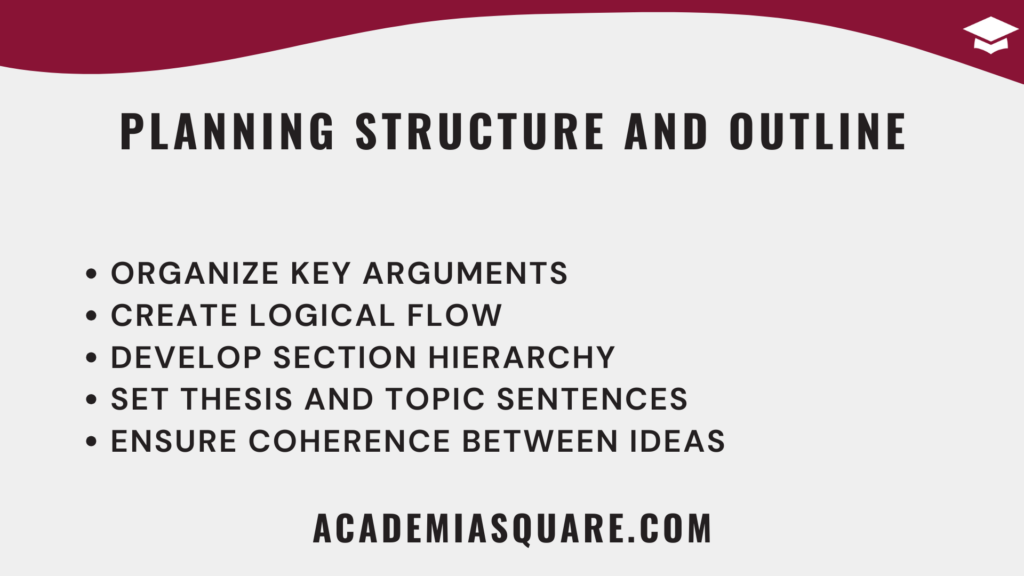
Planning is where ideas take architectural form. It is the stage of the writing process that transforms creativity into clarity. By structuring your ideas into an outline, you turn abstract thinking into a logical sequence that readers can follow effortlessly. Planning is not merely organizational; it is a form of strategic reasoning that connects your argument’s purpose, evidence, and flow.
According to Hayes and Nash (2019, Journal of Educational Developmental Psychology), writers who plan before drafting achieve greater content coherence and exhibit stronger argument continuity. The act of outlining helps you evaluate whether your ideas build upon one another effectively, reducing the likelihood of redundant or contradictory sections later.
From Ideas to Structure
The first step in planning is to review your prewriting notes and identify recurring themes. Group related ideas and eliminate those that fall outside your purpose. Then decide the order in which points should appear. This hierarchy of ideas becomes the skeleton of your piece.
Common outline structures include:
- Chronological: Presents information or events in time sequence, useful for historical or procedural writing.
- Problem–Solution: States an issue, analyzes causes, and offers resolutions, ideal for essays or reports.
- Comparative: Evaluates similarities and differences between concepts or theories.
- Analytical: Breaks down a concept into components and explores their relationships.
Outlining is not a rigid rule; it is a planning tool that gives direction. The goal is to ensure every section serves a clear purpose and connects smoothly with the next. Each point in the outline should answer a question or support a claim related to your central thesis.
Creating Logical Flow
Planning also involves sequencing ideas for maximum reader comprehension. Strong outlines create rhythm and logic by alternating between examples and analysis. Writers should think about pacing—how much time to spend explaining versus proving. A balanced plan keeps readers engaged while ensuring arguments build naturally.
Visual tools like bullet lists, tables, or conceptual maps can help you visualize progression. These tools reveal whether your reasoning moves in a clear direction or loops back unnecessarily. The goal is for each paragraph to anticipate and prepare for what follows.
Integrating Sources and Evidence
In academic and professional contexts, planning also includes deciding where evidence fits best. Choose specific sections for citations, statistics, or examples. Integrating research early avoids the common issue of inserting sources later without flow or coherence. A well-planned outline connects every claim with credible support, building authority and trustworthiness.
Practical Checklist for Strong Planning
- Start with a one-sentence thesis that summarizes your argument or purpose.
- Identify 3 to 5 main points that directly support that thesis.
- List supporting evidence for each point before drafting begins.
- Check that transitions between sections make logical sense.
- Review the sequence to ensure it matches the expectations of your audience.
Writers who plan effectively rarely face writer’s block because they always know what comes next. Planning turns uncertainty into intention and confusion into progress. As you move to the next step—drafting the first version—you will see how structure liberates creativity by giving your thoughts a clear path to follow.
Step 3 Drafting the First Version
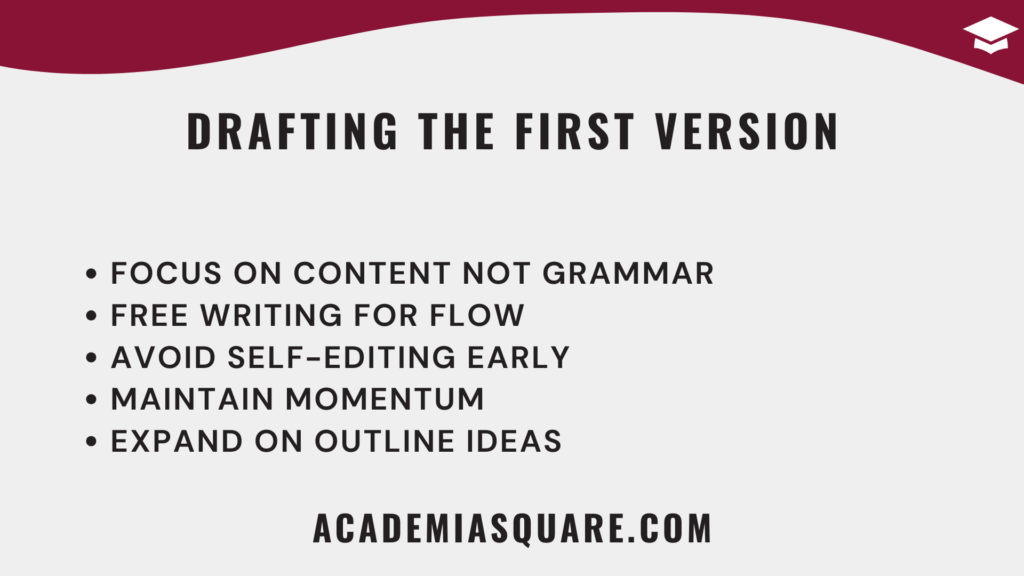
Drafting is where ideas become visible. It is the heart of the writing process, where the raw materials gathered in prewriting and planning finally take shape on the page. Many writers expect perfection during drafting, but that expectation only leads to frustration. The true purpose of drafting is to create momentum—to move your ideas forward in words, not to polish them yet.
As Bereiter and Scardamalia (1987, The Psychology of Written Composition) explain, expert writers focus on developing ideas first and refine later. They separate creativity from critique, allowing freedom of thought before precision of language. This distinction is what keeps drafting productive and prevents paralysis from overthinking.
Building Momentum and Flow
Start by writing continuously without stopping to evaluate each sentence. The goal is to sustain thought and rhythm. Drafting is not the place for correction—it is the place for expression. You can use techniques such as:
- Timed Writing: Set a timer for 25 minutes and write without pause until it rings. This technique, based on the Pomodoro principle, helps bypass hesitation.
- Section Focus: Concentrate on one part of your outline at a time, ensuring steady progress rather than jumping between ideas.
- Placeholder Notes: If you get stuck, insert a note like “[check citation]” or “[expand example]” instead of stopping.
Writing with a Reader in Mind
Even during drafting, awareness of the reader improves clarity. Imagine how your audience will interpret each paragraph. Ask yourself: Is my purpose visible here? Writers who maintain audience focus tend to produce more coherent arguments and stronger engagement. Studies from the UNC Writing Center suggest that reader awareness during drafting reduces the number of major revisions later.
Dealing with Self-Criticism
One of the biggest obstacles in drafting is the inner critic. Many writers stop mid-sentence to correct grammar or rephrase. Resist that urge. Early editing disrupts flow and prevents your ideas from fully emerging. Remember, every professional writer produces messy first drafts. The draft is not the final product—it is the scaffolding that supports the structure to come.
Turning Fragments into Form
After the first pass, step back and review what you have. You do not need to revise deeply yet, but note where transitions feel abrupt or where ideas need expansion. You can label these spots for later improvement. What matters most is that the text exists. You cannot revise a blank page, but you can refine an imperfect one.
Effective drafting embraces imperfection as a necessary stage of discovery. Once you have written your first version, the next step is to transform it into something stronger through deliberate revision.
Step 4 Revising and Refining the Draft
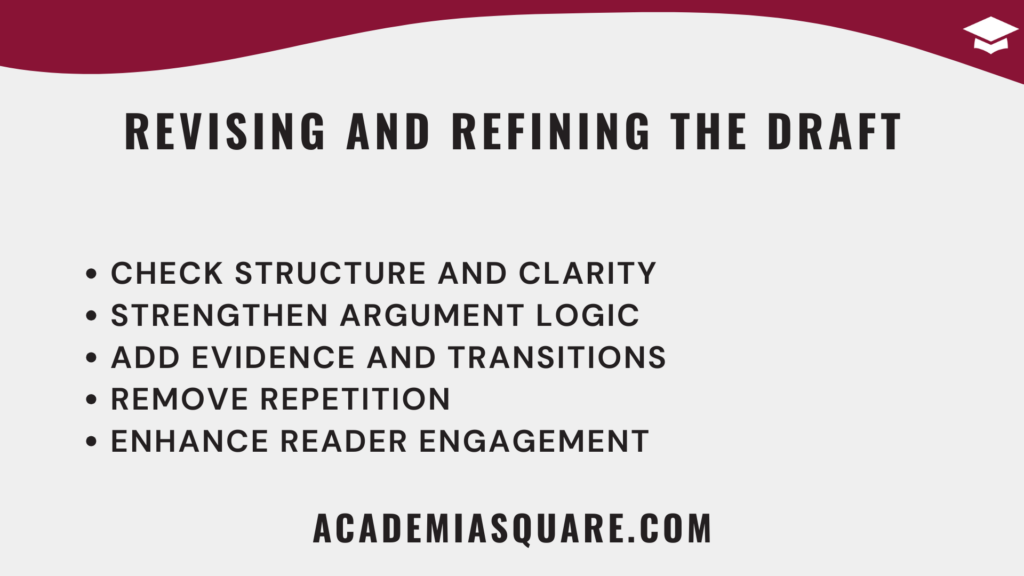
Revision is where writing becomes artful and precise. The word itself comes from the Latin “revidere,” meaning “to see again.” This stage invites you to look at your work with new eyes—to rethink, restructure, and refine. In the writing process, revision is not polishing commas; it is about improving ideas, logic, and meaning.
Research consistently shows that revision is the strongest predictor of final writing quality. Dunlosky et al. (2013, Psychological Science in the Public Interest) emphasized that writers who practice strategic revision produce texts that are both clearer and more persuasive. Revision is thinking in motion—it transforms raw thoughts into coherent communication.
Rethinking Structure and Argument
Start by reviewing your text from a distance. Ignore grammar for now and look for logic. Does each paragraph serve the main idea? Does evidence appear in the right places? Are transitions smooth? Many writers find it helpful to print the draft or read it aloud, as seeing and hearing the text differently exposes inconsistencies.
Ask questions like:
- Is the thesis clear and consistently supported?
- Does each paragraph contribute a unique point?
- Have I shown how my ideas connect rather than simply listed them?
Improving Clarity and Coherence
Once structural revisions are complete, focus on clarity. Simplify long sentences, cut redundancy, and ensure transitions signal relationships between ideas. Effective coherence makes readers feel guided rather than lost. Tools such as concept maps or reverse outlines can help visualize how ideas flow from one section to another.
Deepening Analysis and Evidence
Revision is also the time to strengthen reasoning. Add examples, refine citations, and integrate sources more strategically. Academic writing benefits from specificity; general claims rarely convince without evidence. According to the Journal of Academic Development, writers who integrate evidence during revision rather than initial drafting achieve higher argument accuracy and credibility.
Peer Review and Reflection
Having another reader engage with your draft can reveal blind spots. Ask peers or mentors for feedback on clarity, tone, and logic. Take notes on what they found confusing or compelling. The most effective revisers treat feedback as data—not judgment—and use it to strengthen the piece.
Each round of revision refines focus and depth. The process may feel repetitive, but every adjustment improves flow, precision, and confidence. Once meaning and structure are solid, you can move into the fine-tuning phase: editing and proofreading.
Step 5 Editing Proofreading and Final Touches
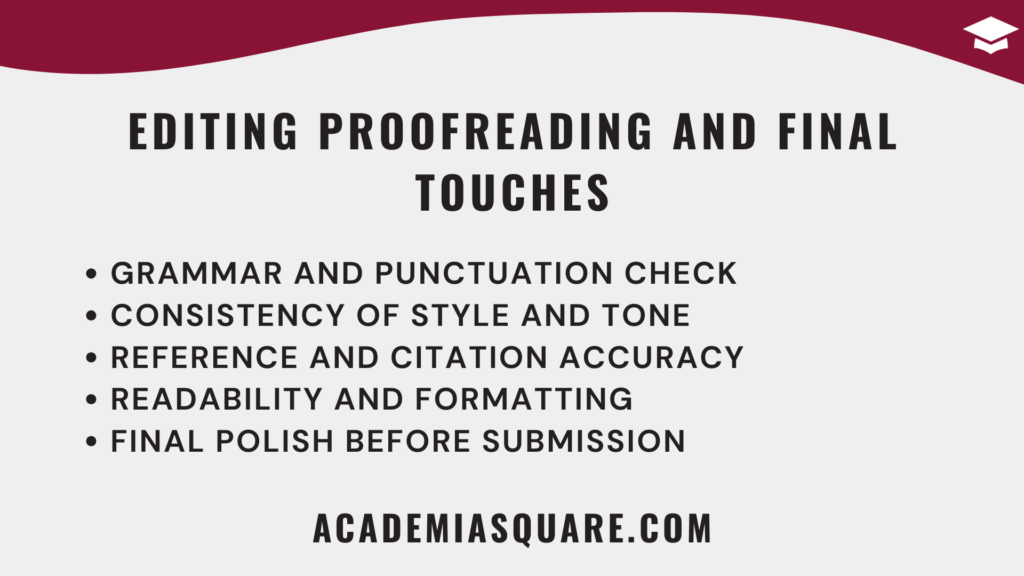
Editing and proofreading represent the final phase of the writing process, where precision and presentation take center stage. Editing deals with language, flow, and style, while proofreading ensures correctness in grammar, punctuation, and formatting. Together, they polish your message so that readers focus on ideas rather than errors.
According to Hyland (2022, Journal of Writing Research), attention to clarity and conciseness at this stage significantly improves reader comprehension and perceived professionalism. Well-edited writing signals respect for the reader’s time and intelligence, which is essential in both academic and professional contexts.
Editing for Style and Flow
Start by addressing readability. Eliminate unnecessary words, replace vague expressions with precise ones, and vary sentence length for rhythm. Look for overused phrases and ensure transitions feel natural. Each paragraph should begin with a clear topic sentence that leads logically into the next.
Check consistency in tense, voice, and formatting. Readers should not notice style shifts; smoothness communicates confidence. Academic studies show that consistent tone improves reader trust and memory retention.
Proofreading for Accuracy
Proofreading is detail work, but it has high impact. Correct punctuation and grammar maintain professionalism and credibility. Effective proofreading strategies include:
- Read the text slowly from the end to the beginning to isolate spelling errors.
- Use grammar-checking tools as support, but never rely on them completely.
- Print your document or change its font to view it with fresh perspective.
- Check all references, page numbers, and formatting consistency.
Errors distract readers and undermine strong ideas. Take breaks before proofreading; distance improves detection accuracy. Even minor typos can distort meaning and weaken your authority.
Formatting and Presentation
At this final stage, confirm alignment with formatting requirements such as font size, citation style, and spacing. Academic and professional audiences expect precision not just in ideas but in presentation. A well-formatted piece communicates seriousness and competence.
Final Review and Confidence
Before submission, read your work one last time for flow and tone. Ask whether the introduction promises what the conclusion delivers. If every part aligns with your purpose, you have achieved the full writing process—from idea to polished product. This final pass is less about finding mistakes and more about appreciating the coherence that comes from a disciplined process.
With the draft refined, revised, and perfected, your text is now ready to represent your ideas with clarity, accuracy, and professionalism. The next chapters will show how this process adapts to different genres and contexts while maintaining its universal logic of discovery, structure, and refinement.
Using the Writing Process for Different Text Types
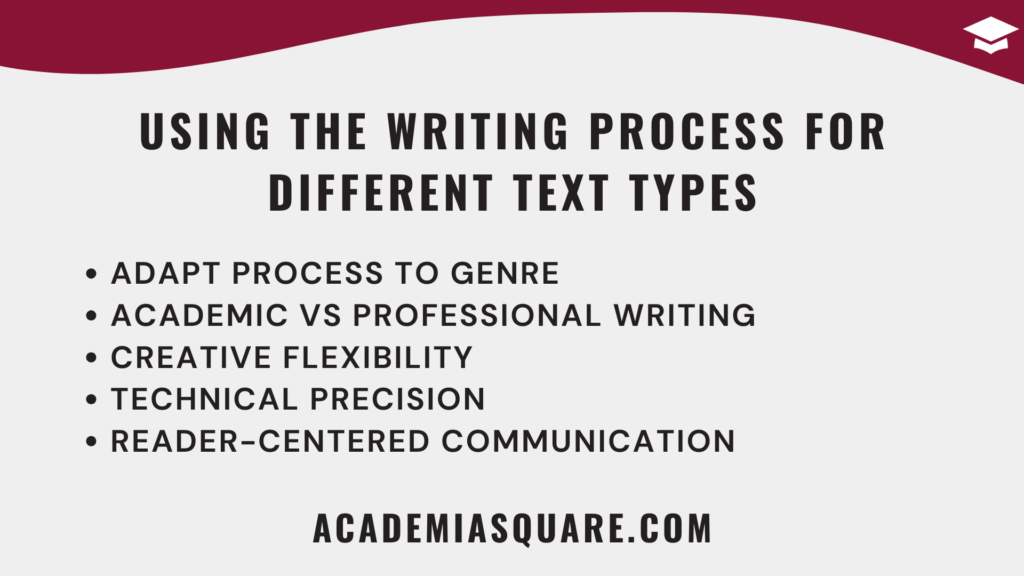
The writing process is adaptable to every form of writing. While its stages remain constant, each genre—academic, professional, creative, or technical—demands a slightly different approach. Understanding how to tailor the process to various text types allows you to write more effectively, no matter your context.
As Hyland (2019, Journal of Second Language Writing) explains, the most successful writers are those who adjust their process according to purpose and audience expectations. Whether composing a research paper, report, essay, or article, applying flexibility within structure is what defines advanced writing skill.
Academic Writing
In academic writing, structure and evidence are paramount. The prewriting and planning stages take more time here, as they involve research, citation, and argument development. Drafting focuses on clarity of logic, while revision ensures that every claim is supported by verifiable data. Formatting and citation accuracy also become part of the editing process. Each stage must reinforce intellectual rigor and transparency.
Professional and Business Writing
For reports, proposals, or workplace communication, the writing process prioritizes conciseness and reader orientation. Planning involves identifying the decision-makers or stakeholders and anticipating their questions. Drafting favors short paragraphs, active voice, and clear headings. Revision ensures that tone matches professionalism and purpose—polished, courteous, and to the point.
Creative and Reflective Writing
In creative writing, such as essays, blogs, or narratives, prewriting and drafting often blend. Writers may discover direction while composing, then return to planning afterward. Revision focuses less on logic and more on rhythm, tone, and emotional resonance. According to Kellogg (2013, Educational Psychologist), this fluid approach enhances creative output by encouraging associative thinking before structured editing begins.
Technical and Research Writing
Technical writing demands extreme clarity and precision. Prewriting includes understanding data, methodology, and audience literacy. Planning involves outlining detailed sections—methods, results, discussion—while drafting aims for factual accuracy. Revision eliminates ambiguity and ensures reproducibility. Proofreading focuses on numerical accuracy, units, and terminology consistency.
Recognizing these genre-based differences strengthens versatility. The writing process is not a single path but a flexible framework that evolves with each purpose. Mastering it allows you to move confidently between academic essays, technical documents, and creative pieces without losing structure or clarity.
Common Mistakes in the Writing Process and How to Avoid Them
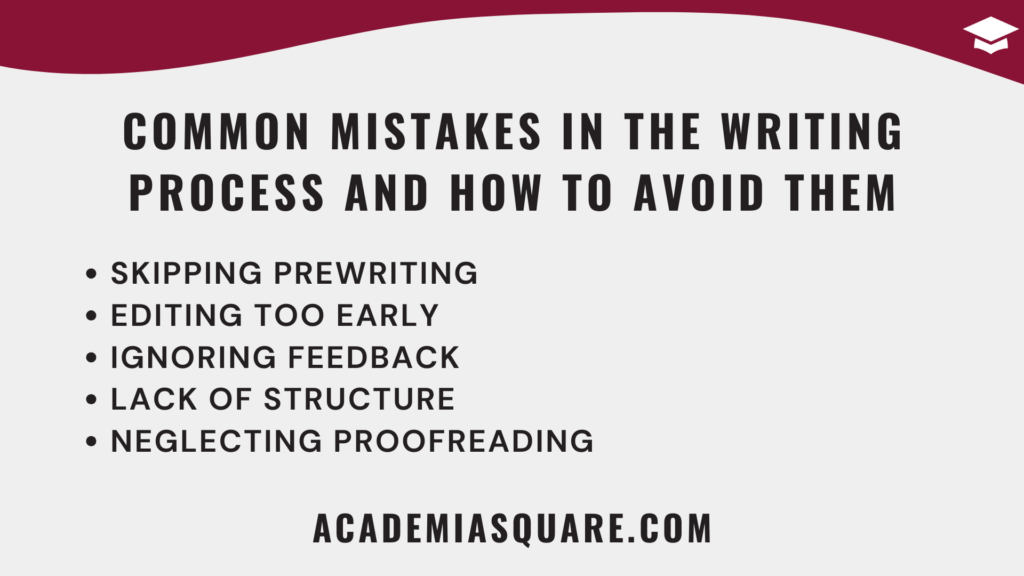
The most frequent mistakes in the writing process arise from misunderstanding its purpose or skipping key stages. Many writers rush through prewriting, ignore structure, or edit prematurely. Others assume revision means fixing grammar instead of refining ideas. Knowing these pitfalls—and how to avoid them—saves time and greatly improves final quality.
According to a review in the Written Communication journal (2021), writers who neglect planning and structured revision are 40 percent more likely to produce disorganized texts. Avoiding these habits turns writing from a chore into a deliberate act of communication.
Skipping Prewriting or Research
Without prewriting, writers lack direction. Skipping this step results in vague arguments and repetitive phrasing. The fix is simple: dedicate at least 15 percent of your writing time to idea generation, note-taking, and outlining before drafting. This preparation clarifies both goals and structure.
Writing Without a Plan
Jumping into drafting without an outline produces uneven pacing and gaps in logic. Planning acts as the map that guides your writing. Even a basic list of sections with short notes under each heading is enough to maintain coherence. The Purdue OWL Writing Lab emphasizes that even minimal outlines increase productivity and clarity.
Editing Too Early
Writers often try to edit while drafting, which interrupts thought flow and causes frustration. Early editing forces you to focus on surface errors instead of developing ideas. Keep a separate stage for editing after revision, when the core argument is already solid.
Ignoring Feedback
Feedback is a key part of the writing process, yet many writers dismiss it or take it personally. Constructive critique identifies weaknesses that are invisible to the author. Seek readers who understand your goals and invite honest feedback on clarity and tone. Treat their input as data for revision rather than judgment.
Neglecting Proofreading
Errors that seem minor can undermine credibility. Proofreading is your safeguard against distraction and misunderstanding. Use a checklist to catch formatting issues, typos, or inconsistencies. Reading aloud or printing your text helps detect mistakes your eyes skip on-screen.
These mistakes are universal, but they are also preventable. By respecting each stage of the writing process—planning, drafting, revising, editing—you build habits of discipline and reflection. Writing becomes a skill under your control rather than a challenge left to chance.
Examples of the Writing Process in Action
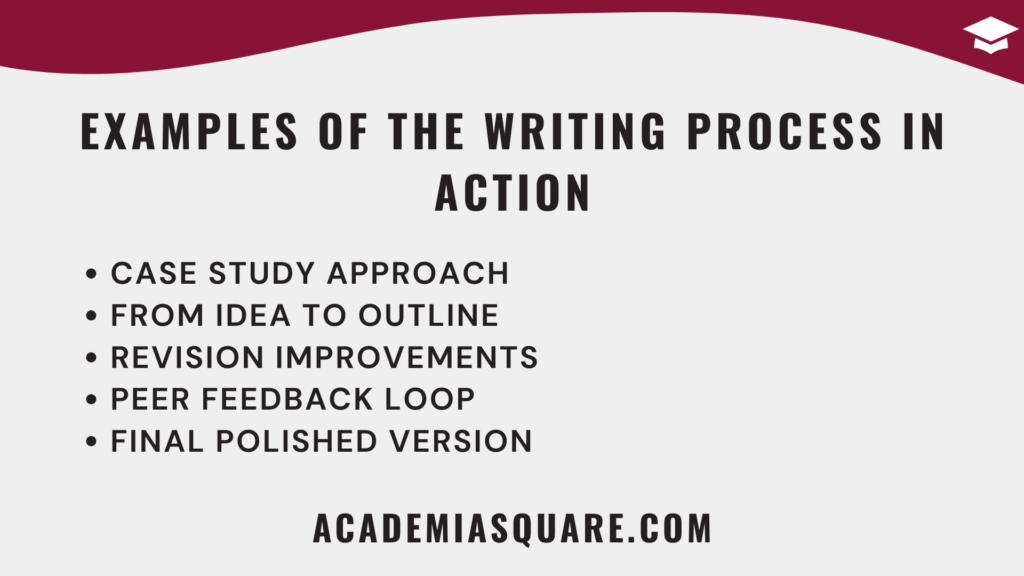
Seeing the writing process in practice reveals how theory transforms into tangible progress. This section traces how a short piece evolves through the five stages—from an initial idea to a polished final version. Observing this transformation makes it easier to apply the same logic to your own work.
Let us imagine a student preparing a short essay on the topic “The Role of Urban Gardens in Sustainable Cities.” At first glance, it seems simple, but every stage of the writing process refines it into clarity and depth.
Prewriting Stage
The student begins by brainstorming associations: sustainability, community gardens, food security, and biodiversity. After reading studies such as Bendt et al. (2020, Urban Forestry & Urban Greening), they decide to focus on how urban gardens foster social inclusion. The main question becomes: How do shared green spaces strengthen sustainable communities?
Planning and Outlining Stage
Next, they create a simple outline:
- Introduction: Define urban gardens and sustainability goals
- Body Paragraph 1: Environmental benefits (biodiversity, reduced heat islands)
- Body Paragraph 2: Social and cultural benefits (community building, food access)
- Conclusion: Urban gardens as catalysts for social sustainability
This outline serves as a logical framework for drafting and ensures balance between environmental and social dimensions.
Drafting Stage
During drafting, the student writes freely without worrying about perfection:
Urban gardens transform unused land into productive community spaces. They create environmental value while promoting social connection. By providing access to green areas, they enhance local sustainability and wellbeing.
The goal is to express key ideas quickly, leaving refinements for later.
Revising Stage
After reviewing feedback from a peer, the writer realizes the argument lacks evidence. They insert examples from case studies and strengthen transitions between environmental and social benefits. The revised paragraph now flows logically and presents more depth.
Editing and Final Touches
Finally, grammar and citation formatting are checked. The text is read aloud to test rhythm and clarity. The writer shortens long sentences and replaces general terms with specific ones such as “urban greening initiatives” and “community-led projects.”
The finished version is concise, structured, and research-informed. It illustrates how each stage of the writing process adds value—first by discovering, then organizing, refining, and finally perfecting ideas.
By following similar steps, any writer can turn a vague concept into a clear, purposeful piece of writing. The process is repeatable yet flexible, and mastering it turns writing from guesswork into deliberate creation.
Tools and Techniques to Support the Writing Process
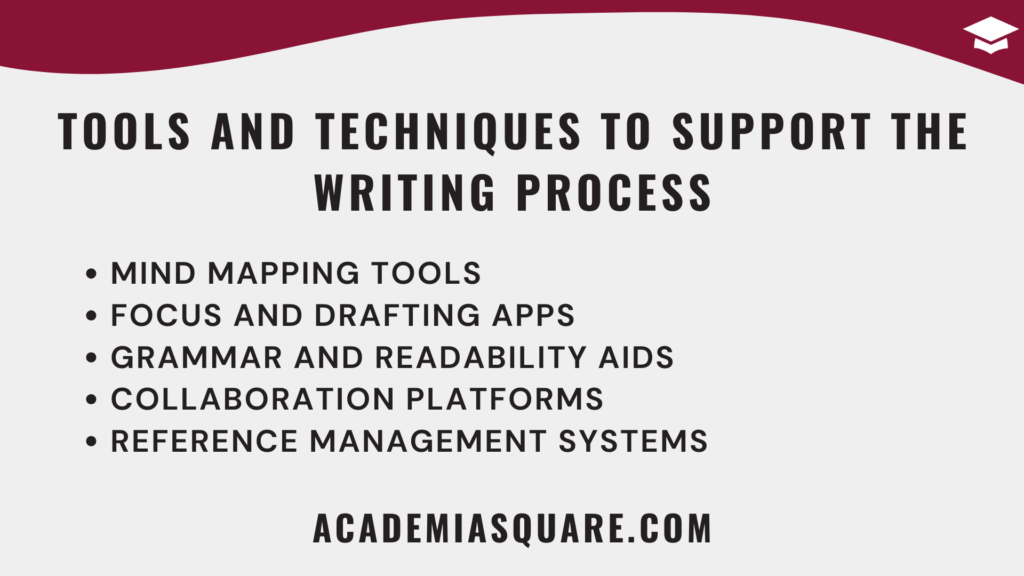
Technology and cognitive tools have become essential allies in the modern writing process. Whether you are drafting an academic essay, preparing a report, or creating creative content, using the right tools can streamline every stage—from brainstorming to proofreading. While no tool replaces critical thinking, the right combination of digital and analog techniques can help you write more efficiently and with greater confidence.
According to Mangen and van der Weel (2015, Computers in Human Behavior), digital writing environments enhance planning and revision by offering instant feedback and easier reorganization of ideas. However, they also emphasize that tools work best when paired with reflection and manual review. This chapter explores a mix of digital resources and human techniques that complement the writing process without controlling it.
Tools for Prewriting and Idea Generation
Idea formation benefits from flexible, visual, and nonlinear tools. Applications like MindMeister and Miro help you map connections between ideas. For writers who prefer text-based brainstorming, Notion and Obsidian allow hierarchical note-taking and backlinking for conceptual exploration.
Traditional methods remain powerful too. Handwritten notes, sticky diagrams, or whiteboard outlines enhance recall and encourage deeper engagement. Combining analog and digital approaches often produces the best balance between creativity and organization.
Techniques for Drafting and Focus
During drafting, distraction control is crucial. Tools like FocusWriter or Cold Turkey remove digital interruptions, while minimalist editors such as iA Writer keep the page clean and calming. Timeboxing methods, like the Pomodoro technique, help maintain flow by alternating short writing sessions with brief breaks.
Voice typing or dictation tools can also accelerate first drafts by turning spontaneous thought into text. This approach works especially well for brainstorming narrative or exploratory sections.
Support for Revision and Collaboration
Revision benefits from tools that visualize feedback. Platforms like Google Docs and Overleaf allow for comments and tracked changes, making collaboration transparent. Grammar analysis tools such as Grammarly or LanguageTool highlight issues of tone, structure, or clarity—but use them critically. Always confirm that their suggestions align with your intent and discipline standards.
Editing and Proofreading Aids
Final checks can be supported by readability analyzers such as the Hemingway Editor, which flags overly complex sentences. Reference managers like Zotero or Mendeley ensure consistent citation style and accurate referencing across drafts. However, the human eye remains irreplaceable; no algorithm can match the intuition and nuance of a careful reader.
When combined thoughtfully, these tools enhance both the efficiency and precision of the writing process. The secret lies in using them strategically, not mechanically. As your process matures, you will learn which technologies complement your natural rhythm and which ones distract from it.
Feedback Revision Loops and the Nonlinear Nature of the Writing Process
The writing process is rarely linear. Writers move back and forth between stages—planning, drafting, revising, and even prewriting again—as their ideas evolve. This recursive movement is not a flaw but a sign of maturity in writing. Great writing emerges through cycles of feedback and revision that refine understanding and expression with every pass.
The recursive model was first formalized by Flower and Hayes (1981), who described writing as a dynamic system of planning, translating, and reviewing. Their research showed that writers constantly re-evaluate goals and restructure content as new insights emerge. This loop-based approach mirrors how professionals and academics refine complex ideas through repeated iteration.
Understanding Feedback as Development, Not Criticism
Feedback should be seen as guidance, not evaluation. It reveals how readers interpret your ideas, helping you detect blind spots. Constructive critique identifies unclear reasoning, weak transitions, or unconvincing evidence. Writers who welcome this external perspective accelerate their learning curve and avoid repeating the same mistakes.
Effective feedback involves asking specific questions, such as:
- What is the main takeaway from this section?
- Where does the logic feel incomplete or rushed?
- What tone or impression does this text create?
The Role of Self-Review and Reflection
Feedback is not only external. Self-review helps you maintain internal consistency and awareness of growth. After each major draft, take notes on what worked, what changed, and what still feels uncertain. Reflection strengthens metacognition—the ability to think about your own thinking—which enhances future writing performance. Research in Teaching in Higher Education by Wingate (2012) showed that reflective writing practices significantly improve analytical quality and self-regulated learning.
Designing a Revision Loop
To apply feedback efficiently, design deliberate revision cycles rather than random edits. A structured feedback loop might look like this:
- Draft the initial version without worrying about perfection.
- Review it yourself for clarity and logic after a short break.
- Share it with a peer or mentor and gather focused feedback.
- Revise based on feedback and reflect on what improved.
Each pass deepens insight and refines language. Over time, this cycle becomes natural and automatic—every paragraph you write benefits from accumulated awareness of what works and what does not.
Embracing the Nonlinear Path
Writing rarely follows a straight line from beginning to end. It twists, circles, and refines as understanding evolves. Recognizing this nonlinear nature reduces frustration and fosters resilience. Skilled writers anticipate returning to earlier stages and use each return as an opportunity for discovery rather than a setback.
When feedback and reflection are integrated into your routine, writing becomes a process of continuous improvement rather than a single act of production. You stop chasing perfection and start building precision, one iteration at a time.
Conclusion and Checklist on the Writing Process
The writing process becomes truly powerful when it is embedded as a habit. Mastery is less about talent and more about routine choices that compound over time. When you treat writing as a repeatable system you reduce decision fatigue, sustain momentum, and steadily raise quality. Research on expert performance shows that deliberate practice with clear goals and timely feedback produces consistent improvement. See Flower and Hayes 1981 for the cognitive model that frames writing as ongoing planning and reviewing, and Dunlosky et al. 2013 for evidence on strategy training and self regulation.
Make the process visible. Writers who track stages make better choices. A short note that records today you planned, tomorrow you draft, and later you revise prevents confusion and promotes focus. Visibility also supports motivation since progress is easier to notice when each stage is named and checked off. For program level guidance, see the landmark synthesis in Graham and Perin 2007, which recommends explicit teaching of planning, drafting, and revision strategies for durable gains.
Build a routine that respects energy and attention
Schedule short blocks for drafting when energy is high and use lower energy periods for editing or citation checks. Protect planning time so that drafting never begins without a direction. Many writers benefit from one deep session for idea development and one lighter session for language cleanup. This rhythm matches the recursive nature of the writing process by letting you return to earlier thinking with a clearer mind.
- Pair tasks with context. Do research and outlining where reference material is easy to access, and move to a distraction free space for drafting. The environment reminds your brain what type of thinking to perform.
Use feedback loops to accelerate growth
Invite targeted feedback on argument strength, evidence placement, and reader impact. Ask reviewers to mark the sentence they remember most and the sentence that caused confusion. Close the loop by revising quickly while insights are fresh. This practice develops metacognition, the skill of monitoring your own thinking, which is central to high level writing performance as documented in Dunlosky et al. 2013.
Create a personal knowledge system
Store notes, quotes, and outlines where they can be retrieved and remixed. Tag sources by theme and by stage so that you can pull example rich material during revision rather than hunting for it. A lightweight system is better than an elaborate one that you never maintain. The goal is friction reduction so that ideas move smoothly through the stages of the writing process.
Plan for sustainability
Mastery means you can keep writing when life gets busy. Keep a parking lot of next actions for stalled projects. Keep a bank of model paragraphs that show how to frame a thesis, introduce a section, or transition between ideas. When time is short, complete one small action that moves a draft forward rather than waiting for a perfect block of hours.
Aim for steady gains, not sudden leaps. Your process matures each time you complete a full cycle from idea to polished text. Protect that cycle, keep evidence close, and favor small consistent practices over irregular marathons. With routine feedback and mindful iteration, the writing process becomes a reliable path to clear thinking and confident expression for every project you take on.
Sources and Recommended Reading on the Writing Process
- Purdue Online Writing Lab. “Stages of the Writing Process.” Purdue University.
- University of Kansas Writing Center. “The Writing Process.” University of Kansas.
- University of York. “The writing process – assignment writing: a practical guide.”
- Wingate, Ursula (2012). “Using academic writing to enhance student learning.” Teaching in Higher Education.
- Dunlosky, John et al. (2013). “Improving Students’ Learning with Effective Learning Techniques.” Psychological Science in the Public Interest.
- Taib, Siti Aishah et al. (2024). “The Cycle of Writing Difficulties and Writing Stages.” International Journal of Academic Research in Business and Social Sciences, Vol. 14(6).
- Hyland, Ken (2019). “The role of genre and writing process in second-language writing.” Journal of Second Language Writing.
- Taylor & Francis Author Services. “Write and structure a journal article well.”
- AcademiaSquare. “How to Read Critically: Complete Guide for Beginners.”
- AcademiaSquare. “The Best Study Techniques According to Research (2025).”
FAQs on the Writing Process
What is the writing process?
The writing process is a structured sequence of stages that transforms ideas into finished text. It typically includes prewriting, planning, drafting, revising, and editing. Research by Flower and Hayes (1981) identified writing as a recursive cognitive process in which writers continuously plan, translate, and review their ideas.
Why is understanding the writing process important?
Understanding the writing process improves clarity, structure, and confidence. Studies in Written Communication (2023) show that writers who consciously follow process stages produce more coherent and persuasive work than those who write without planning or revision.
What are the five stages of the writing process?
The five stages are prewriting (idea generation), planning (outlining and organizing), drafting (developing content), revising (improving structure and logic), and editing (refining grammar and clarity). These steps are supported by the Purdue Online Writing Lab as the foundation of effective academic writing.
Is the writing process always linear?
No, the writing process is nonlinear and recursive. Writers often return to earlier stages as new insights emerge. This cyclical pattern was confirmed by Flower and Hayes’ cognitive model and later supported by Wingate (2012), who found that iterative revision deepens analytical quality and argument development.
How does the writing process improve academic writing?
Following the writing process improves academic performance by promoting reflection, coherence, and evidence-based reasoning. Research in the Journal of Writing Research (2022) found that structured writing instruction significantly enhances clarity and reader comprehension in academic texts.
What happens during the prewriting stage?
Prewriting involves brainstorming, reading, note-taking, and identifying the audience and purpose. It is the stage where you shape your core ideas. According to Hyland (2019, Journal of Second Language Writing), effective prewriting predicts stronger argumentation and coherence in final drafts.
What is the difference between revising and editing?
Revising focuses on content and organization—improving logic, flow, and argument strength—while editing targets language accuracy such as grammar, punctuation, and style. The revision stage ensures meaning, and editing ensures precision. Educational research by Kellogg (2013) demonstrated that separating these stages increases writing efficiency and quality.
How can feedback improve the writing process?
Feedback helps writers recognize blind spots and refine structure. A 2022 study in Written Communication found that iterative feedback loops improve argument coherence by up to 35 percent. Constructive comments also build metacognitive awareness, which supports lifelong writing development.
What are common mistakes in the writing process?
Frequent mistakes include skipping prewriting, writing without a plan, editing too early, and ignoring feedback. The Purdue OWL emphasizes that these errors result in disorganized and less persuasive writing. Avoid them by following each stage deliberately and revisiting earlier steps when needed.
How long does the writing process take?
The length of the writing process depends on text complexity and revision depth. Academic essays often require several sessions spread across days or weeks. Research from the University of Kansas Writing Center suggests that spacing writing sessions over time improves retention and overall quality.
How can I improve my writing process?
Improvement comes from practice, reflection, and feedback. Keep a log of what works and what slows you down. Studies summarized by Graham and Perin (2007) recommend teaching explicit strategies for planning and revising to achieve long-term writing gains.
Is the writing process different for creative and academic texts?
Yes. Creative writing values flexibility and discovery during drafting, while academic writing emphasizes evidence and structure. However, both follow the same core process: idea development, organization, drafting, and revision. As Hyland (2019) notes, awareness of audience and purpose unites all effective writing approaches.
What tools support the writing process?
Digital tools like collaborative editors, mind mapping apps, and citation managers can enhance workflow, but they must support—not replace—critical thought. Mangen and van der Weel (2015) found that technology improves organization when paired with deliberate reflection and manual review.
Can mastering the writing process improve long-term success?
Absolutely. Mastering the writing process develops transferable skills such as planning, critical thinking, and communication. Research in Written Communication and Dunlosky et al. (2013) confirms that strategic writing practices correlate with higher academic achievement and professional effectiveness.


